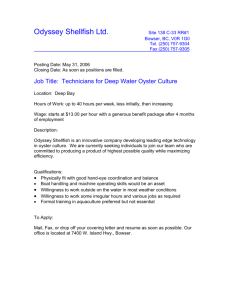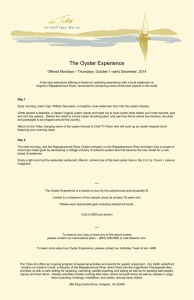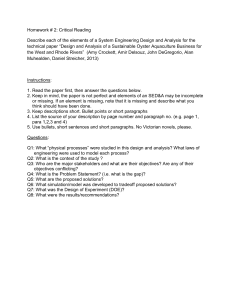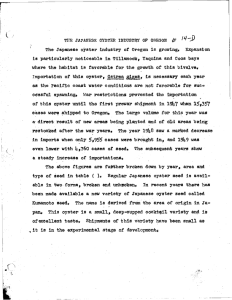OYSTER FARMING AND EXTERNALITIES: A BIOECONOMIC APPROACH
advertisement
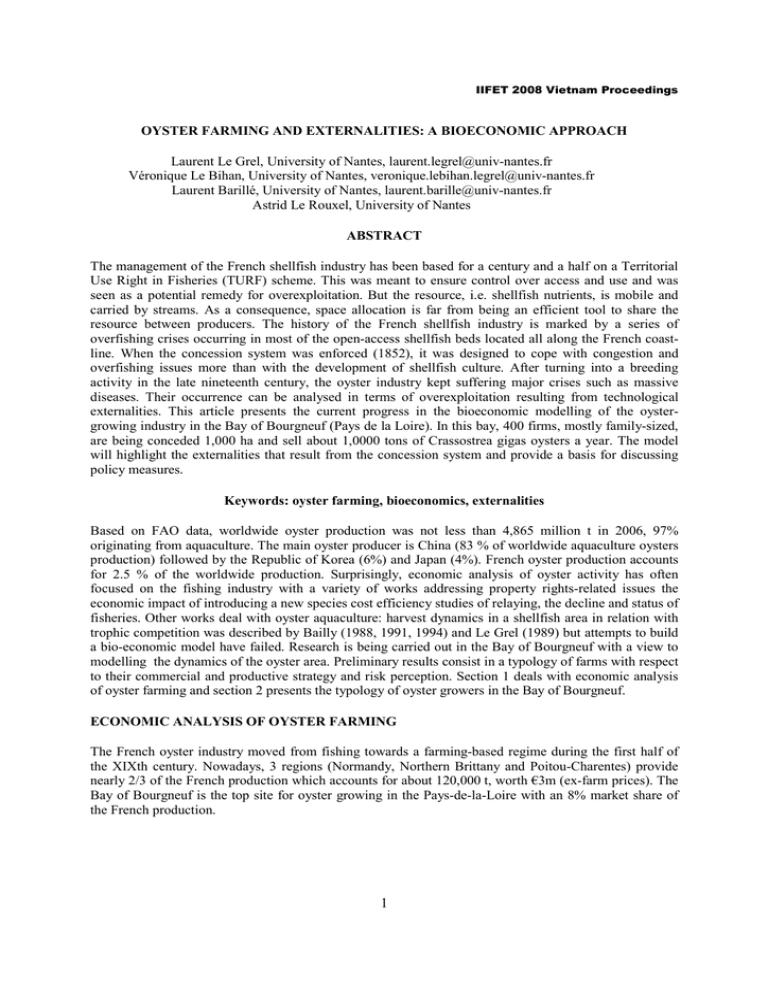
IIFET 2008 Vietnam Proceedings OYSTER FARMING AND EXTERNALITIES: A BIOECONOMIC APPROACH Laurent Le Grel, University of Nantes, laurent.legrel@univ-nantes.fr Véronique Le Bihan, University of Nantes, veronique.lebihan.legrel@univ-nantes.fr Laurent Barillé, University of Nantes, laurent.barille@univ-nantes.fr Astrid Le Rouxel, University of Nantes ABSTRACT The management of the French shellfish industry has been based for a century and a half on a Territorial Use Right in Fisheries (TURF) scheme. This was meant to ensure control over access and use and was seen as a potential remedy for overexploitation. But the resource, i.e. shellfish nutrients, is mobile and carried by streams. As a consequence, space allocation is far from being an efficient tool to share the resource between producers. The history of the French shellfish industry is marked by a series of overfishing crises occurring in most of the open-access shellfish beds located all along the French coastline. When the concession system was enforced (1852), it was designed to cope with congestion and overfishing issues more than with the development of shellfish culture. After turning into a breeding activity in the late nineteenth century, the oyster industry kept suffering major crises such as massive diseases. Their occurrence can be analysed in terms of overexploitation resulting from technological externalities. This article presents the current progress in the bioeconomic modelling of the oystergrowing industry in the Bay of Bourgneuf (Pays de la Loire). In this bay, 400 firms, mostly family-sized, are being conceded 1,000 ha and sell about 1,0000 tons of Crassostrea gigas oysters a year. The model will highlight the externalities that result from the concession system and provide a basis for discussing policy measures. Keywords: oyster farming, bioeconomics, externalities Based on FAO data, worldwide oyster production was not less than 4,865 million t in 2006, 97% originating from aquaculture. The main oyster producer is China (83 % of worldwide aquaculture oysters production) followed by the Republic of Korea (6%) and Japan (4%). French oyster production accounts for 2.5 % of the worldwide production. Surprisingly, economic analysis of oyster activity has often focused on the fishing industry with a variety of works addressing property rights-related issues the economic impact of introducing a new species cost efficiency studies of relaying, the decline and status of fisheries. Other works deal with oyster aquaculture: harvest dynamics in a shellfish area in relation with trophic competition was described by Bailly (1988, 1991, 1994) and Le Grel (1989) but attempts to build a bio-economic model have failed. Research is being carried out in the Bay of Bourgneuf with a view to modelling the dynamics of the oyster area. Preliminary results consist in a typology of farms with respect to their commercial and productive strategy and risk perception. Section 1 deals with economic analysis of oyster farming and section 2 presents the typology of oyster growers in the Bay of Bourgneuf. ECONOMIC ANALYSIS OF OYSTER FARMING The French oyster industry moved from fishing towards a farming-based regime during the first half of the XIXth century. Nowadays, 3 regions (Normandy, Northern Brittany and Poitou-Charentes) provide nearly 2/3 of the French production which accounts for about 120,000 t, worth €3m (ex-farm prices). The Bay of Bourgneuf is the top site for oyster growing in the Pays-de-la-Loire with an 8% market share of the French production. 1 IIFET 2008 Vietnam Proceedings Steps in oyster aquaculture production Located on the Atlantic coast of France, the Bay of Bourgneuf is 34,000 ha wide. The area devoted to oyster culture is about 1,000 ha. Oysters Mussels Wild Mussels Polders Sources: En Carta in Sogreah 2004 and Barillé-Boyer et al., 1997 Figure 1. The Bay of Bourgneuf and oyster seabeds Oyster growing moved from fishery to aquaculture after the World war II when farmers from the major French oyster area, Marennes-Oléron, settled in the bay. Around 400 farms sell 10,000 t out of which 8,000 are produced locally (the remainder being purchased or grown outside). Oysters are grown off-bottom in intertidal zone using racks and mesh bags. The average production cycle is briefly described in figure 2. It takes three to four years to achieve market size depending on the type of seed (wild or hatchery-reared diploids and triploids with a higher growth rate). Oysters are sold and served raw on a half shell. It should be noted that productivity diminished in the eighties such as many growers decided to move their cultivated stocks to other regions. Since 2005, seabeds have been undergoing restructuring. Productivity has improved (even though evidence of a link between both phenomena cannot be offered). 2 IIFET 2008 Vietnam Proceedings Figure 2. Schedule of a production cycle in the Bay of Bourgneuf Resource allocation Ancient races of aquaculture can be found in France but fishing remained the main way of harvesting oysters in France till the Middle-Ages and the Renaissance. According to Héral (1989), the beginning of oyster farming in France dates back to the XVIIth century, first thanks to the redeployment of salted marshes, then by use of specific tanks. Flat oyster spat (the native species) was hand-picked on stones at low tide or dredged ashore on subtidal beds. Oyster were grown in ponds, called claires in French, during 4 to 5 years in a few places on the Atlantic coast, near the Marennes-Oléron area. The history of the French shellfish industry was marked by a series of crises caused by overexploitation of public beds, especially from 1720 (Neild, 1995, p. 78). All along the French coastline, oyster fisheries closed down, sometimes during several years, sometimes only during the breeding season, in order to preserve the resource. High pressure on natural beds promoted the development of oyster aquaculture. Two major technological innovations made it possible between 1857 and 1860. Firstly, the introduction of Crassostrea angulata, the Portuguese cup oyster: imported to offset the lack of native flat oyster Ostrea edulis in the Arcachon area this invasive species colonised the whole Bay of Biscay in 25 years. Its faster growth rate compared with the flat oyster’s favoured an increase in production. On the other hand, methods to sever spat from collectors were fully mastered in 1860. This decisive step was the key to moving from storage on to real growing activities. Production increased significantly while the proportion of flat oysters went down. This history was then marked by a succession of production peaks followed by sharp production drops. More recently, in the late Sixties, the Portuguese oyster experienced massive, virus-induced mortality rates. It was replaced by an imported species, the Pacific oyster C. gigas. In the Seventies the flat oyster 3 IIFET 2008 Vietnam Proceedings was itself the victim of two parasites. Production of cupped oyster C. gigas expanded quickly while quantities of flat oyster remained at a low level. Héral (1989) notes that this succession of crises may be the result of overinvestment patterns based on an individual rationality but inefficient from a collective point of view. This raises the question of management tools. The allocation of resources is based on a space scheme. The legal system for leased bottoms dates back to 1852 and 1853 legislation. The use of public grounds to produce shellfish is subject to authorisation. This concession is revocable, has no duration limit and is not transferable. The law was amended several times during the XXth century in order to adjust legal texts to practices. In 1915 more particularly, these use rights became transferable free of charge although it was commonly known that many transactions were subject to payment. The reason lies in the inalienability of the public domain. Transfers subject to payment are allowed by the law of 1983 which retains the principle of inalienability but justifies the transaction price as a means to cover expenses for maintaining and improving the public domain. Studies have shown that a market does exist for these use rights and that prices tend to equalise the present value of future benefits (Mongruel & Thébaud, 2006; Mongruel et al., 2007). This system of Territorial Use Rights in Fisheries (TURFs) regulates access to costal areas. It is relevant in managing congestion on public grounds but not in allocating resources since the latter is mobile and remains collective property. In the public maritime domain, each French oyster-farming area is organised according to a structural plan (Schéma des structures) of aquaculture businesses1. The plan determines the size of the farms (in terms of acreage allotted from the public maritime domain) and lays out relevant provisions to promote a better distribution of the saltwater areas required for biological productions. As regards the continental part of the Bay of Bourgneuf, the reference minimum size (dimension minimale de référence or DMIR) for growing out with racks and bags for oysters is 0.8 ha2; the reference maximum size (dimension maximale de référence or DMAR3) is 15 ha. The number of tables and mesh bags per ha is 700 and 4,000 respectively. For the insular part of the bay, the minimum size is 1.2 ha for for growing out on rack and bag for oysters; the maximum size is 7.5 ha. Framing density is limited to 3,000 linear metres of tables per ha (three-meter-long tables hence 1,000 tables per ha). The number of pockets per table or per acre is not subject to regulation; neither is the number of oysters per mesh bags. Structural plans thus provide for the distribution of farming space between professionals with minimum sizes that should allow them to secure a sufficient income to sustain an average-size family business and maximum sizes allowing access to land to the great majority of professionals. However, they do not guarantee a fair distribution of the biological resources (nutritional elements) required for oyster growth. Thus all shell-farming facilities have an impact on hydrodynamism and the availability of nutriments in the whole area. The fee payable for leased bottom is made up of a fixed amount (for instance €91 in 2005) for an area no larger than 1 ha, €182 otherwise) and a variable amount depending on the seabed location and the area (in 2005, between €1.5 and €3 /ha). 1 As provided by article 4.1 of decree n° 83.228 of 22 March 1983 as amended. 0.8 ha =1.97 acres; 15 ha = 37.06 acres; 1.2 ha = 2.96 acres; 7.5 ha = 18.53 acres; 1 ha = 2.47 acres. 3 A reference minimum size, corresponding to the acreage that should be allotted to an average family business in the area. The reference maximum size is the maximum area that can be allotted to a farm whatever its legal status and the number of farmers in the area. 2 4 IIFET 2008 Vietnam Proceedings Even if this scheme has achieved its purpose of maintaining an oyster industry while the regime of public grounds implemented in England led to the collapse of fisheries (Neild 1995), it does not prevent externalities: the quantity of resources available for a given producer depends on what has been caught by the farmers located in the upstream part of the food flows. This leads each producer to increase the quantity of seed in order to catch maximum resources. As a consequence the total quantity of seed exceeds the natural capacity of the area. This relation underlies the succession of crises that has been observed in France since the emergence of an oyster farming industry. Externalities Harvest dynamics in a shellfish area is based on competition for resources and consists in a continuing increase of the biomass until the area is overloaded. It has been described by Bailly (1988, 1991, 1994) and Le Grel (1989). For low levels of biomass, production increases following the law of decreasing marginal returns: in a given area, an increase in the seed results in a diminishing marginal increase in the production as the biomass gets close to the maximum load. Figure 1 translates this relationship into economic terms (the total revenue RT is deducted from the physical model by a homothetic transformation of the production curve, multiplied by the price, assumed to be constant). The level of seed S* reaches the biological optimum since production does not increase anylonger whatever the increase in the seed. S* is the minimum seed quantity to get the maximum revenue). From this point, production stagnates as the area is overloaded. Growth and mortality performances fade until the level of seed S2 is reached, where overinvestment becomes such that the ecosystem break down. Mortality can affect all shellfish. Such a view is not merely theoretical as it refers to the way the Portuguese oysters disappeared 40 years ago or the massive death of flat oysters in Europe in 1922-1923. Furthermore, since late June 2008 the French oyster farming industry has been experiencing an unexplained massive mortality rate affecting young animals all along the French coast. The decrease in performances is spread over time so that oyster farmers do not make the link between their behaviour and its consequences. This disconnection is favoured by the atomistic structure of the industry. 5 IIFET 2008 Vietnam Proceedings total revenue total cost TR TC cultivated stock 0 Se S* S1 S2 Figure 3. Total revenue and total cost in a shellfish basin It should be added that competition for primary productivity is not the only reason which explains this pattern. If prices decrease when supply rises, producers tend to offset the diminishing unit margin by increasing their production, and thus their seed. Assuming that production costs are proportional to the production, a total cost curve (CT) can be added in figure 1. From S*, it would have been expected that total cost become constant and the curve horizontal. But losses in mortality and growth rate induce new costs for farmers: more work is needed to produce an oyster as far as the total seed increase. Total cost thus still increases but at a lower rate than before S*. Total profit is measured by the gap between total revenue and total cost curves. The economic optimum is reached for a level of seed Se where this gap is maximum. For S1 profit is null (S1 may be located before or after S2, level of growing stock corresponding to the biological limit for which a production is possible). Without management measures, competition for resource will lead to situations on the right-hand side of the revenue curve that are associated with low levels of collective profit. Possible measures include density or surface limits, taxes… They will affect growers differently according to their characteristics and strategies: non-paid labour in family farms, addition to the local production of oysters grown outside (which induces a lower dependence on the local growth performances)… Thus a first step to build a relevant bio-economic model is to establish a typology of farmers. TYPOLOGY OF OYSTER FARMERS A survey was undertaken among oyster farmers during the fall of 2007. The questionnaire revolved around four topics: the characteristics of the farms, the farmers’ activities (technical and commercial choices), the reasons underpinning their technical and commercial choices, risk perception and adaptation strategies. The sample comprised 43 undertakings (representing 14% of all shellfish farms in the Pays de la Loire) established between 1950 and 2005 (1988 average). In four out of five cases the farmer was a man aged around 43 on average. Two-thirds of those surveyed ran individual businesses, one-fifth a farming public limited company. On average, these units employed three persons full time, two of whom belonged to the 6 IIFET 2008 Vietnam Proceedings farmer’s family. The businesses owned an average 5.53 ha7 with 4.83 ha 12 acres devoted to farming. Sold tonnage amounted to 57.76 tons for a 50.21-ton output. Direct sale on markets or on the premises constituted the most common outlet – a characteristic shared by 49% of the sampled undertakings. Factorial design In view of the limited sample (43 individuals) and the unbalanced distribution of some modalities, the typological analysis of shellfish farming in the Bay of Bourgneuf was carried out using five active binary nominal variables: -Two of these variables describe the strategies underpinning the use of production factors: location of oyster beds (Are oyster beds exclusively located in the Bay of Bourgneuf or not? What is the share of family work in the total workforce?) -One variable synthetises the commercial strategy (Is direct sale predominant or not?) -A fourth variable describes the establishment’s past growth phase (has the activity level increased or not in the past five years?) - One last covers risk perception (Is the degree of risk perception high or low?) Figure 4. Factorial design 1-2 Factorial design 1-2 (Diagram 1) indicates on the horizontal axis the opposition between family businesses (family workforce involvement greater than 70%) that wish to remain small and therefore work locally and sell their products on markets or on the premise to more dynamic businesses located in other areas, that make use of paid workforce and prefer other outlets to direct sale. The vertical axis opposes businesses according to their degree of risk perception. 7 5,53 ha = 14 acres; 4.83 ha = 12 acres. 7 IIFET 2008 Vietnam Proceedings Categories of farmers The analysis reveals a distribution between three categories: Low risk perception 2 1 Family establishments Big establishments 3 High risk perception Figure 5. Typology of oyster-farmers in the Bay of Bourgneuf The distinction between category 1 on the one hand and categories 2 and 3 on the other hand appears on the horizontal axis which describes the range of technical and production choices. Categories 2 and 3, on the contrary, are separated on the vertical axis (risk perception), which raises difficulties as regards translating such difference in terms of structure and business strategy. In order to both specify the nature of this distinction and relate it to an operational accounting typology, variables such as the farmers’ age, tonnage outputs and sold tonnages, turnovers and farmed area were used to characterise the categories more accurately. Investment dynamism is also a source of dichotomy between categories 2 and 3. Category 1 16 businesses Farms located in several areas, with high production levels to meet the demand from various distribution networks Category 2 9 businesses Family businesses with local outlets run Actives variables - Work outside the bay, - Low share of family work - Activity level on the rise - Low percentage of direct sale -Businesses with no increase in activity level in the last five years, -Low risk perception, especially related to environmental deterioration on the one hand and management-related risks on the 8 Continuous variables - An average 37% of the farmed areas are located outside the Bay of Bourgneuf - Average tonnage output: 85.5 t. => 70- to 100-ton output corresponding to a turnover category of €250 to €1,500,000 - Average sold tonnage: 96t - larger farmed areas : average farmed area: 7,92 ha Greater-than-average percentage of seasonal work - Age above the sample’s average (50 to 43) - Businesses less affected by seasonal variability of sales the average farm IIFET 2008 Vietnam Proceedings by nearly-retired farmers with no investment dynamics. Category 3 18 businesses Young farmers running family concerns in a growth phase. other hand, - low perception of management- No member of the youngest age group related risks in its market-related (23-40) in this segment. risk aspect -Businesses working in the Bay of - Better perception of marketBourgneuf related and regulatory risks - High family workforce involvement - High perception of management-related risks, especially farmer’s illness-related risks -Half the businesses farm 2 to 3 ha of land -Less seasonal work than in category 1 -No member of above-70t tonnage group in this segment. This typology is relevant as it allows to establish a link between commercial and productive strategies on the one hand, business risk on the other. Implication in terms of modelling For the time being, the connection between the hydraulic, biological and the economic modules is under construction. The hydraulic model is crucial as the circulation of primary productivity is subject to the flows. As far as biological and economic modules are concerned, group 2 is used as a case study (temporarily assuming that it is representative of the area) with the following assumptions: these producers wish to realise a revenue corresponding to the sale of a 25t-tonnage –a tonnage that employs the available workforce. Each business wishes to realise a revenue of 25, 000 kg * €3.5/ kg, that is to say €87,500. The issue for each farmer is to minimise costs. With a stable available workforce (family business) and in the absence of any investment dynamics (retirement preparation), the only cost adjustment variable is the cultivated stock The sum of all individual decisions indicates a 10,000t-production for 400 businesses in the area, which corresponds to 162.5 million marketable-size oysters (for an 80-gramme oyster and a 30% mortality rate during one cycle) and a €35m revenue. Let us assume that the end-of-cycle production is 8,000t. Each farmer, faced with lower-than-expected revenue, decides to increase their cultivated stock in proportion to the shortfall. With a constant sale price (€3.5/kg) he decides to farm 62,500 more oysters (5,000 divided by 0.08kg). This corresponds to 32.5m more oysters for the area. Let us then assume that the end-of-cycle tonnage is 9,500t -a shortfall which induces each farmer to once again increase their cultivated stock. The result is a rise in production that is less than proportional to the rise in cultivated stocks. Diminishing marginal productivity entailed diminished margins for professionals who keep on overinvesting in cultivated stocks in the hope of making up for diminishing unitary margins. This leads to the following equations: Objective function: minimising costs (C) under the constraint of a desired activity level (Revenue level) 9 IIFET 2008 Vietnam Proceedings With (for L = labour and K=capital): dC = 0 (family business), dL dC = 0 (dying business, no investment) dK The revenue in year n corresponds to the production obtained with the cultivated stocks (Sn-1) since the previous year (year n-1) and sold at a price (P) (production cycles are assumed to be one year long). Rn = f LB ( S n −1 ) * P (where f LB is the oyster growth function) At the beginning of cycle n, the producer will put the initial number of oyster beds plus a number of oysters in proportion of the gap to the expected revenue (R*) to the shortfall: R * − Rn S n = S n −1 + * (1 + k ) m*P With m as a marketable oyster’s average mass (80 g) and k as the death rate used by farmers to anticipate their needs in terms of cultivated stocks. CONCLUSION The bioeconomic model of the oyster-growing industry in the bay of Bourgneuf article is under construction. A typology of growers distinguishes three categories of businesses as regards their commercial and productive strategies and the riskiness of their activity. These groups will respond in a different manners to management options dealing with areas or cultivated stock limitations and taxes. The model will allow to assess the impact of these measures on the whole area and identify the fall in profits among farmers. The model will also provide the basis for an assessment of the analysis of economic consequences of space distribution according to oyster maturity stages. ACKNOLEWDGEMENTS This work was carried out as part of the Gerrico Research Project, funded by the region of Pays-de-laLoire. The authors acknowledge the support they received from the program. They are also grateful to Olivier Taviot, Legal English teacher, Faculty of Law and Politics of Rennes1 for his very helpful assistance with translation. REFERENCES Allen P. G., LW. Botsford, A.M. Schuur and W. E. Johnston (1990) Bioeconomics of aquaculture, Developments in aquaculture and fisheries science, volume 13, third edition, Elsevier, 351 p. Committee on Nonnative Oysters in the Chesapeake Bay, 2003, Nonnative Oysters in the Chesapeake Bay, National Academies Press, Washington, 344 p. Bailly, Denis, 1988, Aspects économiques et sociaux de la gestion des bassins conchylicoles, Rivages et Cultures n°6, p. 6-8, mai. 10 IIFET 2008 Vietnam Proceedings Bailly, Denis, 1991, Aspects économiques et sociaux de la gestion des bassins conchylicoles: le cas de Marennes-Oléron, ICES mar. Sci. Symp., 192 : 234-241. Bailly, Denis, 1994, Économie des resources naturelles communes : la gestion des basins conchylicoles, Thèse de doctorat de l’Université de Rennes I, 311 p. Bosch Darrel J. and Leonard A. Shabman. “The Decline of Private Sector Oyster Culture in Virginia: Causes and Remedial Policies.” Marine Resource Economics 6 (1989): pp. 227-243 Bosch, Darell J. and Leonard A. Shabman, 1990, Reversing the Decline of Private Oyster Planting in the Chesapeake Bay: An Evaluation of Policy Strategies, Virginia Agricultural Experiment Station, Virginia Polytechnic Institute and State University, Blackburg, July, 62 p. Bosch, Darell J. and Leonard Shabman. “Simulation Modeling to Set Priorities for Research on Oyster Production.” American Journal of Agricultural Economics 72.2 (May 1990): pp. 371- 381. Dumont, Philippe, 1986, Analyse de l’ostréiculture, Inra Économie et sociologie rurales, Rennes, 2 vol., 371 & 116 p. Guillotreau, Patrice and Steve Cunningham, 1994, An economic appraisal of the Solent oyster fishery: historical and institutional aspects, Discussion Papers 65, Centre for the Economics and Management of Aquatic Resources.Héral, Maurice, Prou Jean and Jean-Marie Deslous-Paoli, 1986, Analyse historique de la production conchylicole du bassin de Marennes-Oléron (France) in Ceccaldi H. J. et G. Champalbert (ed.), Quatrième Colloque pluridisciplinaire francojaponais(Actes), Symposium Franco-Japonais sur l'Aquaculture, 3, Marseille (France),16-21 sept. 1985 / Société Franco-Japonaise d'Océanographie, Paris (France), p 55-65. Héral, Maurice, 1989, L’ostréiculture française traditionnelle, in Barnabé G. (coord.), Aquaculture, volume 1, coll. Technique et Documentation, Lavoisier Paris, 2d ed., p. 345-393. Le Bihan, Véronique, Le Grel Laurent. and Yves Perraudeau, 2008, L’aquaculture, in Guillotreau Patrice (ed.), Mare economicum, enjeux et avenir de la France maritime et littorale. Coll. Économie et société, Presses universitaires de Rennes. Le Bihan, Véronique, Pardo Sophie and Yves Perraudeau, 2007, La Gestion Globale des Risques en Conchyliculture, Observatoire des pêches et des cultures marines du golfe de Gascogne, AGLIA, 41 p. + annexes Le Grel, Laurent, 1988, Approche économique de la conchyliculture : le cas de l’ostréiculture dans le bassin de Marennes-Oléron, mémoire de DEA économie industrielle et échanges mondiaux, Université de Rennes I, 64 p. + ann. Mongruel, Rémi and Olivier Thébaud, 2006, Externalities, institutions and the location choices of shellfish producers: the case of blue mussel farming in the Mont-Saint-Michel bay (France), Aquaculture economics and management, 10(3), pp. 163-181. Mongruel Rémi, Pérez Agúndez José and SophieGirard, 2007, Le foncier conchylicole, support de droits à produire transférables : une analyse de l’apparition spontanée du marché des concessions conchylicoles, de son fonctionnement et de ses effets non désirés. Les publications Amure, série Documents de travail, n°D-25-2007, 22 p. Neild, Robert, 1995, The English, the French and the oyster, Quiller Press, London, 212 p Philippe, Manuelle. 2001, Contribution à la modélisation bio-économique de l’ostréiculture en eaux profondes dans le bassin de Marennes-Oléron, Mémoire de DESS, Institut Universitaire Européen de la Mer, Brest, 94 p. ENDNOTES 11

